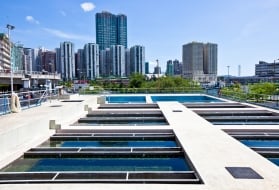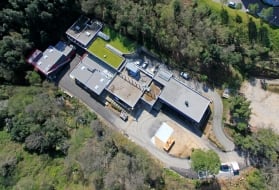area of application
Reading time:surface water grit removal
The water intake must be designed to avoid grit entrainment as much as possible. When local conditions do not allow this provision, include a grit remover unless you accept that the grit can be pumped out of the other structures; in particular, when the plant includes straining (1 to 2 mm mesh for instance), grit removal must be carried out upstream to avoid any incident involving the strainers.
Grit removers are usually rectangular, channel type structures.
Their cross section will depend on target horizontal flow velocity: this velocity must be slightly higher than the critical carry-over velocity VI of particles that have been deposited (table 3) if the grit is to be removed hydraulically, but lower than critical carry-over velocity VI when the bottom scraping is used to remove grit.
The horizontal area is calculated by dividing the maximum flow rate to be carried by sedimentation rate Vc applicable to the smallest size particles to be screened out, according to the horizontal flow velocity selected.
The grit can also be separated out using the cyclone method (hydrocyclone on the lift pump delivery) (see hydrocyclone).
grit removal from UWW
In combined gravity systems, we recommend installing an ungraded waste pit to protect treatment equipment. This system copes with deposits comprising large grit, pebbles, shards of glass or metal objects (see structures)
In the actual grit remover, the proportion of organic matter that settles at the same time as grit can be reduced when the velocity close to the structure’s floor is kept to approximately 0.3 m · s–1 (also known as the sweeping velocity). In fact, the OM/Mm percentage remains high at this velocity: approximately 50%
Improved separation can be achieved either by washing the grit that has been extracted, in which case the organic content in the washed grit must be brought down to less than 30%, or in special reactors where this content can be brought down to below 5 and even 3% (see processing cleaning waste: arenis).
The nature of the product collected requires the use of specifically designed equipment in order to limit the risks of abrasion and blockage (vortex pumps – air emulsifiers).
By rising order of importance and effectiveness, we use:
- the single grit channel grit remover where the flow velocity varies with the output. This system is not much recommended and its use restricted to small improvised plants. The grit is removed manually from a lengthwise trench having a storage capacity of approximately 4 to 5 days;
- the channel grit remover, improved by the inclusion of a linear equation (water depth proportional to output) outlet weir used to maintain a constant flow velocity in the region of 0.3 m · s–1. Contact time: approximately 1.5 to 2 minutes;
- the circular grit remover where the grit is extracted mechanically and the floating matter and scum removed hydraulically (see structures). Contact time approximately 2 to 3 minutes;
- the rectangular aerated grit remover where the grit is extracted mechanically and the floating matter and scum removed hydraulically (see structures). Contact time approximately 2 to 5 minutes;
Both the latter units are ideally suited to an operation combining grit and grease removal (see great removers), and, in fact, are the most widely used.
grit removal from IWW
Grit removal is not required as often in the case of IWW except when plants process large volumes of storm water. One option may consist in using aerated grit removers used on UWW (especially on agri-food effluent).
When processing the effluent discharged by some metallurgical and mechanical industries, grit removal is used to separate out extremely dense particles of iron oxide, granulated slurry or oily scale with apparent densities varying from 2.5 to 4. These abrasive particles settle very rapidly and are present in initial concentrations that range from 0.2 to several grams per litre and require special equipment for pumping out from grit removers (see structures).
sludge pre-treatment
Sludge pre-treatment is mainly used for protecting equipment that is sensitive to fibres and, more rarely, to other hard objects (pebbles, grit, metal parts …) that can be found in sludge.
Most sludge treatment equipment is very sturdy and will cope with coarse debris (e.g. digester, belt filter …); others tend to be more sensitive (centrifugation, heat treatment …).
Types of pre-treatment used:
- «run-of-water» fine bar-screening (no pressure);
- straining using a pressing screw (Strainpress type)
- in-line comminution (rarely used);
- cycloning.
These treatments create new waste similar to that produced by bar-screening.
Bookmark tool
Click on the bookmark tool, highlight the last read paragraph to continue your reading later














